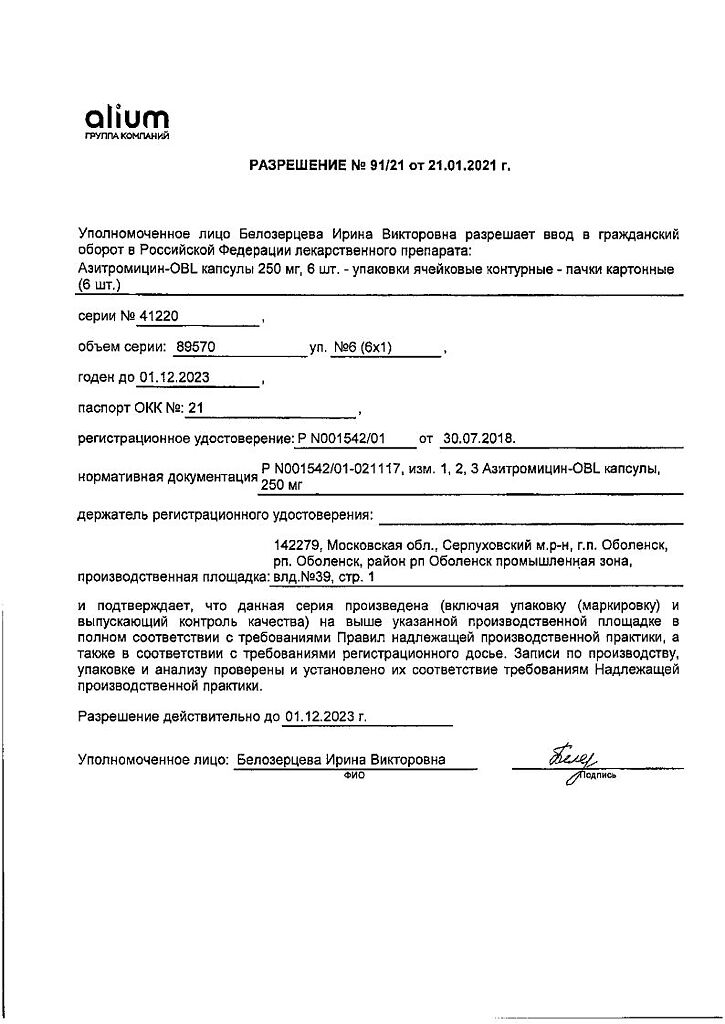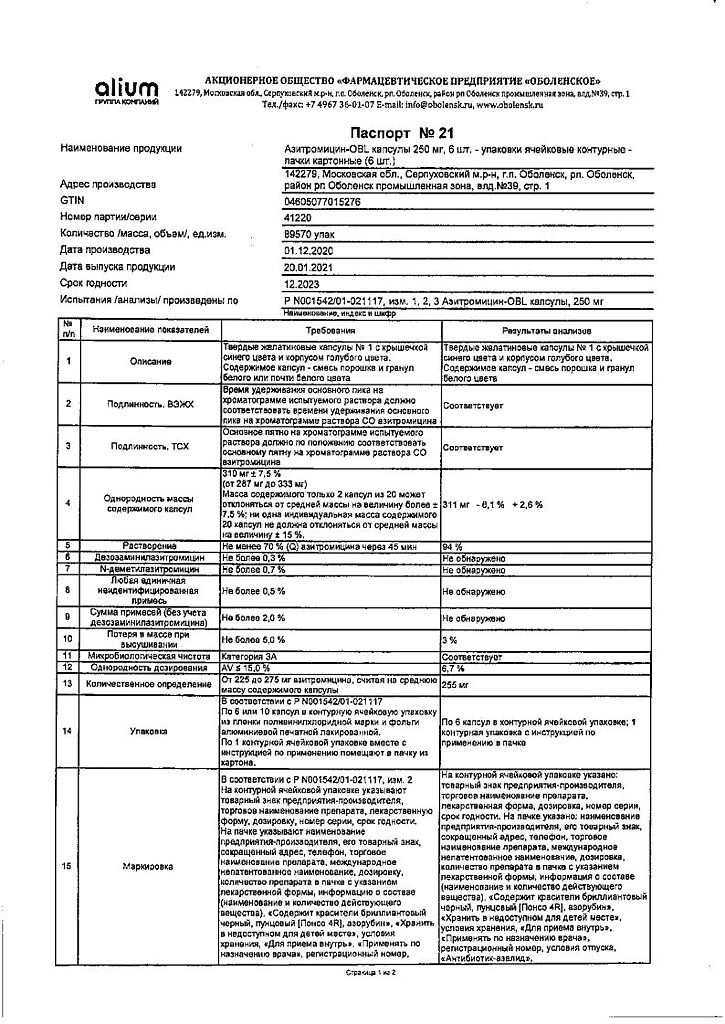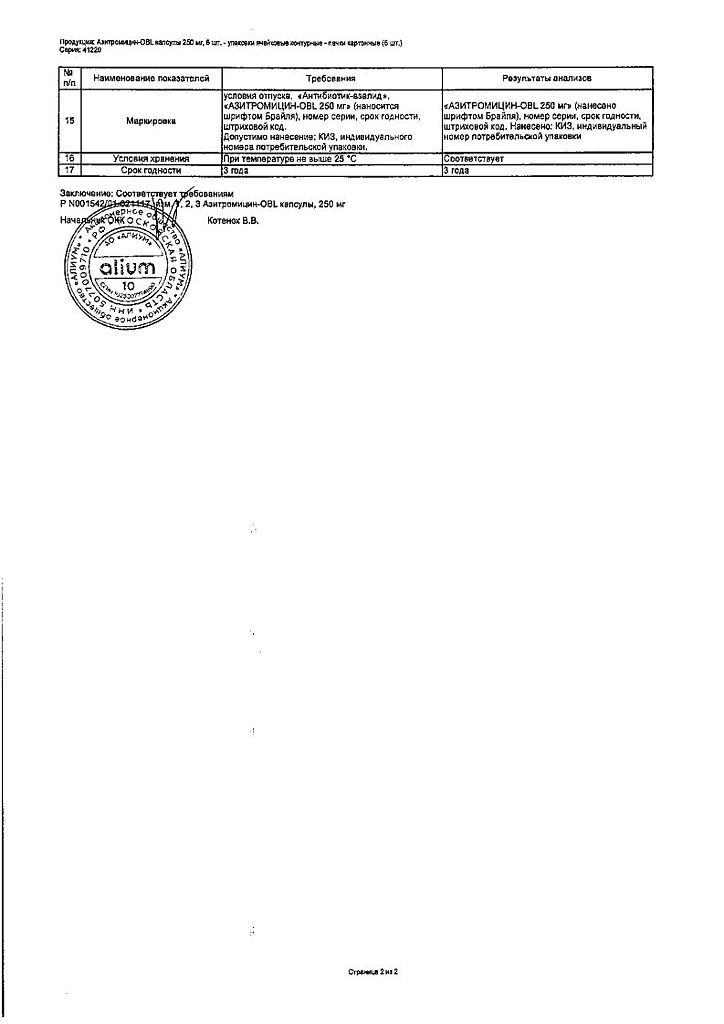No products in the cart.
Azithromycin-OBL, 250 mg capsules 6 pcs
€5.47 €4.56
Out of stock
(E-mail when Stock is available)
Description
Pharmacotherapeutic group:
Azolid antibiotic
Pharmacodynamics:
Azithromycin is a broad-spectrum bacteriostatic antibiotic from the macrolide-azalide group. It has a broad spectrum of antimicrobial action.
The mechanism of action of azithromycin is associated with inhibition of microbial cell protein synthesis. Binding to 50S-subunit of ribosome, it inhibits peptide translocase on the translation stage and inhibits protein synthesis, slowing down the growth and reproduction of bacteria. In high concentrations it has a bactericidal effect.
It has activity against a number of Gram-positive, Gram-negative, anaerobic, intracellular and other microorganisms.
Microorganisms can be initially resistant to the action of the antibiotic or can become resistant to it.
In most cases, susceptible microorganisms
1. Gram-positive aerobes
Staphylococcusaureus Methicillin-sensitive;
Streptococcuspneumoniae Penicillin-sensitive;
Streptococcus pyogenes.
2. Gram-negativeaerobes
Haemophilus influenzae;
Haemophilus parainfluenzae;
p> Legionella pneumophila;
Moraxella catarrhalis;
Pasteurella multocida;
Neisseria gonorrhoeae.
3. Anaerobes
Clostridium perfringens;
Fusobacterium spp.;
Prevotella spp.;
Porphyriomonas spp.
4. Other microorganisms
Chlamydia trachomatis;
Chlamydia pneumoniae;
Chlamydia psittaci;
Mycoplasma pneumoniae;
Mycoplasma hominis;
Borrelia burgdorferi.
Microorganisms capable of developing resistance to azithromycin
Gram-positive aerobes
Streptococcuspneumoniae Penicillin-sensitive.
Initially resistant microorganisms
Gram-positive aerobes
Enterococcusfaecalis;
Staphylococci (methicillin-resistant staphylococci show a very high degree of resistance to macrolides);
Gram-positive bacteria that are resistant to erythromycin.
Anaerobes
Bacteroidesfragilis.
Pharmacokinetics:
Asithromycin is rapidly absorbed from the gastrointestinal tract due to its stability in acidic environments and lipophilicity. It is rapidly distributed throughout the body, and high concentrations of the antibiotic are achieved in the tissues. After oral administration of 500 mg, maximum concentration of azithromycin in blood plasma is reached after 2.5-2.9 hours and is 0.4 mg/l. Bioavailability is 37.5%.
Asithromycin penetrates well into the respiratory tract, organs and tissues of the urogenital tract (in particular the prostate gland), skin and soft tissue.
High concentration in tissues (10-50 times higher than in blood plasma) and long half-life are caused by low binding of azithromycin to blood plasma proteins and its ability to penetrate into eukaryotic cells and to concentrate in low pH environment surrounding lysosomes. This, in turn, determines a large apparent volume of distribution (31.1 L/kg) and high plasma clearance. The ability of azithromycin to accumulate mainly in lysosomes is especially important for elimination of intracellular pathogens.
It is proved that phagocytes deliver azithromycin to sites of infection localization where it is released during phagocytosis. Concentration of azithromycin in the foci of infection is significantly higher than in healthy tissues (on average by 24-34%) and correlates with the degree of inflammatory edema.
Azithromycin is maintained in bactericidal concentrations for 5-7 days after the last dose, which allowed to develop short (3-day and 5-day) courses of treatment.
It is demethylated in the liver; the resulting metabolites are inactive.
The excretion of azithromycin from blood plasma occurs in 2 stages: half-life is 14-20 hours within the period from 8 to 24 hours after taking the drug and 41 hours within the period from 24 to 72 hours, allowing to use the drug once daily.
The drug is mostly excreted with the bile unchanged, a small part is excreted by the kidneys.
Indications
Indications
– Infectious and inflammatory diseases caused by microorganisms sensitive to the drug:
– Infections of the upper respiratory tract and ENT organs (pharyngitis/tonsillitis, sinusitis, otitis media);
– Lower respiratory tract infections: acute bronchitis, exacerbation of chronic bronchitis, including.
– Skin and soft tissue infections (rye, impetigo, secondary infectious dermatosis);
– The initial stage of Lyme disease (borreliosis) – erythema migrans (Erythemamigrans);
– Infections of the urinary tract caused by Chlamydiatrachomatis (urethritis, cervicitis).
Active ingredient
Active ingredient
Composition
Composition
Composition per capsule:
the active ingredient:
azithromycin dihydrate (in terms of azithromycin) – 250 mg.
Auxiliary substances:
Microcrystalline cellulose,
povidone (polyvinylpyrrolidone low molecular weight medical),
crospovidone, calcium stearate, sodium lauryl sulfate.
Capsules hard gelatin No. 1:
Titanium dioxide,
Patent blue dye (patent blue V),
diamond black,
Punsen dye [Ponceau 4R],
azorubin,
gelatin.
How to take, the dosage
How to take, the dosage
Overly, once daily, at least 1 h before or 2 h after a meal.
Adults (including elderly people) and children over 12 years of age with body weight over 45 kg.
Infections of the upper and lower respiratory tract, ENT organs, skin and soft tissue
500 mg (2 capsules) once daily for 3 days (course dose – 1.5 g).
Infections of the skin and soft tissues – 1 g/day on the first day at 1 administration and further 0.5 g/day daily from 2 to 5 days (cumulative dose – 3 g).
In case of erythema migrans
1 g/day for 5 days: 1 day – 1.0 g (4 capsules), then from day 2 to day 5 – 500 mg (2 capsules) (cumulative dose 3.0 g).
Infections of the urogenital tract caused by Chlamydiatrachomatis (urethritis, cervicitis)
Uncomplicated urethritis/cervicitis – 1 g (4 capsules) once.
Prescribing to patients with impaired renal function
Dose adjustment is not necessary for patients with moderate renal impairment (creatinine clearance > 40 ml/min).
Interaction
Interaction
Antacids do not affect the bioavailability of azithromycin, but reduce the maximum concentration in the blood by 30%, so the drug should be taken at least one hour before or two hours after taking these drugs and meals.
Asithromycin does not affect the blood concentrations of carbamazepine, didanosine, rifabutin and methylprednisolone when used together.
In parenteral use, azithromycin has no effect on the blood concentrations of cimetidine, efavirenz, fluconazole, indinavir, midazolam, triazolam, trimethoprim/sulfamethoxazole when used together, but the possibility of such interactions should not be excluded when azithromycin is administered orally.
Asithromycin has no effect on the pharmacokinetics of theophylline, but plasma concentrations of theophylline may be increased when co-administered with other macrolides.
If co-administration with cyclosporine is necessary, it is recommended to monitor blood levels of cyclosporine. Although there are no data on the effect of azithromycin on changes in the blood concentration of cyclosporine, other representatives of the class of macrolides can change its plasma levels.
When digoxin and azithromycin are taken together it is necessary to monitor blood levels of digoxin, because many macrolides increase digoxin absorption in intestine, thereby increasing its plasma concentration.
When warfarin and azithromycin are coadministered, close monitoring of prothrombin time is recommended.
The concomitant administration of terfenadine and macrolide class antibiotics has been found to cause arrhythmias and prolongation of the QT interval. Therefore, these complications cannot be excluded when terfenadine and azithromycin are taken together.
As there is potential for inhibition of CYP3A4 enzyme by parenteral azithromycin when co-administered with cyclosporine, terfenadine, ergot alkaloids, cisapride, pimozide, quinidine, astemizole and other drugs metabolized with this enzyme, the possibility of this interaction should be considered when prescribing azithromycin for oral administration.
When co-administering azithromycin and zidovudine, azithromycin has no effect on the pharmacokinetic parameters of zidovudine in blood plasma or on the renal excretion of it and its metabolite glucuronide. However, the concentration of the active metabolite, phosphorylated zidovudine, in mononuclear cells of peripheral vessels is increased. The clinical significance of this fact is not clear.
The simultaneous administration of macrolides with ergotamine and dihydroergotamine may cause their toxic effects.
Special Instructions
Special Instructions
Do not take with food.
If a dose is missed, the missed dose should be taken as soon as possible and subsequent doses taken 24 hours apart.
A 2-hour break should be observed when concomitant use of antacids.
Hypersensitivity reactions may persist in some patients after treatment withdrawal, which requires specific therapy under medical supervision.
Azithromycin does not affect the ability to drive and operate motor vehicles
Azithromycin does not affect the ability to drive and operate machinery.
Contraindications
Contraindications
– Hypersensitivity to antibiotics of the macrolide group;
– Severe hepatic and renal impairment;
– Children under 12 years of age with a body weight less than 45 kg (for this dosage form);
– Breast-feeding;
– Concurrent use with ergotamine and dihydroergotamine.
With caution:
– moderate impairment of liver and renal function;
– in arrhythmias or predisposition to arrhythmias and QT interval prolongation;
– in co-administration of terfenadine, warfarin, digoxin.
Side effects
Side effects
Allergic reactions: itching, skin rash, angioneurotic edema, urticaria, anaphylactic reaction, including edema (in rare cases with fatal outcome), erythema multiforme, Stevens-Johnson syndrome, toxic epidermal necrosis.
Blood and lymphatic system disorders: thrombocytopenia, neutropenia.
Central nervous system disorders: dizziness/vertigo, headache, seizures, somnolence, paresthesia, asthenia, insomnia, hyperactivity, aggressiveness, anxiety, nervousness.
Sensory organs: tinnitus, reversible hearing impairment to deafness (when taking high doses for a long time), disorders of perception of taste and smell.
Cardiovascular system disorders: rarely – palpitation, arrhythmia, ventricular tachycardia, prolonged QT interval, bidirectional ventricular tachycardia.
Digestive system disorders: nausea, vomiting, diarrhea, abdominal pain/spasms, liquid stools, flatulence, indigestion, anorexia, constipation, discoloration of tongue, pseudomembranous colitis, cholestatic jaundice, hepatitis, changes in laboratory values of liver function, liver dysfunction, liver necrosis (possible fatal outcome).
Motor system disorders: arthralgia.
Urinary system disorders: nephritis, acute renal failure.
Others: vaginitis, candidiasis, photosensitization.
.
Overdose
Overdose
Symptoms: nausea, temporary hearing loss, vomiting, diarrhea.
Treatment:Gastric lavage, symptomatic therapy.
Pregnancy use
Pregnancy use
Prenatal use of the drug is possible only when the estimated benefit to the mother exceeds the potential risk to the fetus.
If it is necessary to prescribe the drug during lactation, breastfeeding should be stopped (excreted with breast milk).
Similarities
Similarities
Additional information
| Conditions of storage | In a dry, light-protected place at a temperature not exceeding 25 °C |
|---|---|
| Manufacturer | Obolenskoe FP JSC, Russia |
| Medication form | capsules |
| Brand | Obolenskoe FP JSC |
Related products
Buy Azithromycin-OBL, 250 mg capsules 6 pcs with delivery to USA, UK, Europe and over 120 other countries.





















